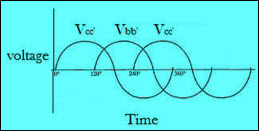Unit 5
Machines
Energy conversion.
An electromechanical energy conversion device is the device that converts electrical energy into mechanical energy or, mechanical energy into electrical energy. Electromechanical energy conversion takes place via the medium of a magnetic field or an electric field, but most practical converters use magnetic field as the coupling medium between electrical and mechanical systems, this is because the electric storing capacity of the magnetic field is much higher than that of the electric field. Electromechanical energy converters are either gross-motion devices such as microphones, loudspeakers, electromagnetic relays, and certain electrical measuring instruments, etc.
DC, induction and synchronous machines are used extensively for electromechanical energy conversion. When the conversion takes place from electrical to mechanical form, the device is called the motor, and when the mechanical energy is converted to electrical energy, the device is called a generator. In these machines, conversion of energy from electrical to mechanical form or from mechanical to electrical from results from the following two electromagnetic phenomena:
- When a conductor is allowed to move in a magnetic field, a voltage is induced in the conductor.
- When a current-carrying conductor is placed in a magnetic field, then a mechanical force is experienced by the conductor.
Construction details of D.C. Machine
Whether machine is D.C. Generator or motor the construction basically remains the same.
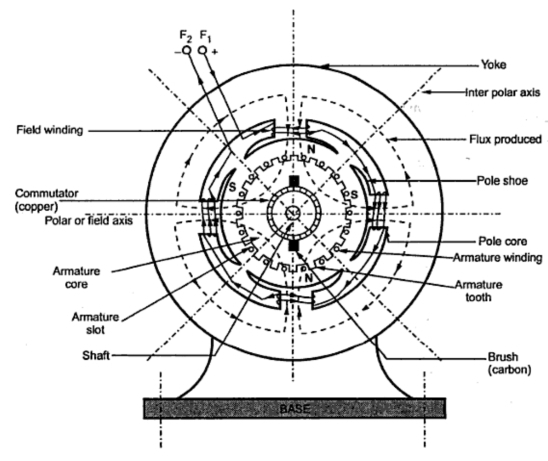
A cross section of typical D.C. Machine
1)Yoke
a) Functions
1. It serve the purpose of outermost cover of the D.C. Machine. So that the insulating materials get protected from harmful atmospheric elements like moisture. Dust and various gases like  , acidic fumes etc.
, acidic fumes etc.
2. It provides mechanical support to the poles.
3. It forms a part of the magnetic circuit.
It provides a path of low reluctance for magnetic flux. The low reluctance path is important to avoid wastage of power to provide same flux large current and hence the power is necessary if the path has high reluctance to produce the same flux.
4.Choice of material: - It is prepared by using cast iron, silicon steel is used which provides high permeability i.e. low reluctance and gives good mechanical strength.
2) Poles
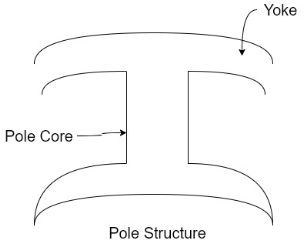
Pole structure
Each Pole is divided into two parts namely
- Pol core
- Pole shoe
Functions of pole core and pole shoe: -
- Pole core basically carries a field winding which is necessary to produce the flux.
- It directs the flux produced through air gap to armature core to the next pole.
- Pole shoe enlarge the area of armature core to come across the flux, which is necessary to produce larger induced e.m.f. To achieve this, sports shoe has been given a particular shape.
Choice of material: -
It is made up of magnetic material like cast iron or cast steel.
As it requires a definite shape and size, laminated construction is used. The laminations of required size and shape are stamped together to get a pole which is then bolted to the yoke.
3) Field Winding (
The field winding is wound on the pole core with a definite direction.
a)Functions:-
To carry current due to which pole core on which the field winding is placed behaves as an electromagnet, producing necessary flux.
As it helps in producing the magnetic field i.e. exciting the poles as an electromagnet it is called Field winding or Exciting winding.
b) Choice of material:-
It has to carry current hence obviously made up of some conducting material.
So aluminium or copper is the choice. But field coils are required to take four types of shape and bent about pole core and copper has good pliability i.e. it can be bend easily. So copper is the proper choice field winding is divided into various coils called field coils. These are connected in series with each other and wound in such direction around pole cores, such that alternate 'N' and 'S' poles are formed.
The total number of poles is denoted as P.
4) Armature
The armature is further divided into two parts namely
- Armature core
- Armature winding
1.Armature core:- Armature core is cylindrical in in shape mounted on the shaft. It consists of slots on its periphery and air ducts to permit the air flow through armature which serves cooling purpose.
a) Functions-
1) Armature core provides house for armature winding i.e. armature conductors.
2)To provide the path of low reluctance to the magnetic flux produced by the field winding.
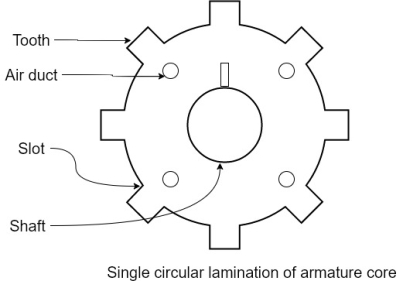
b) Choice of material: -
As it has to provide a low reluctance path to the flux, it is made up of magnetic material like cast iron or cast steel.
It is made up of laminated construction to keep Eddy current loss as low as possible. A single circular lamination used for the construction of armature core is shown in figure.
3. Armature winding
Armature winding is nothing but the interconnection of the armature conductors placed in the slots provided on the armature core periphery.
When the armature is rotated in case of generator magnetic flux gets cut by armature conductors and e.m.f gets induced in them.
a) Functions
1) curvatures of e.m.f takes place in the armature winding in case of generators.
2) To carry the current supplied in case of D.C. Motors.
3) To do the useful work in the external circuit.
b) Choice of Material: -
As armature winding carries entire current which depends on external load, it has to be made up of conducting material which is copper.
5.Commutator
The basic nature of e.m.f in the armature conductors is alternating. This needs verification in case of D.C. Generator, which is possible by a device called commutator.
a)Functions:
1)To facilitate the collection of current from the armature conductors.
2) To convert internally developed alternating e.m.f to unidirectional (D.C.) e.m.f.
3) To produce unidirectional torque in case of motors
b) Choice of Material:-
As it collects current from armature, it is also made up of copper segments.
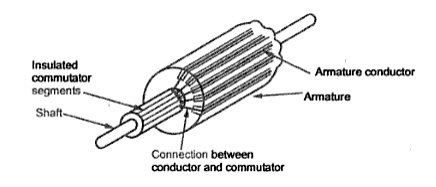
It is cylindrical in shape and is made up of wedge-shaped segments of hand drawn high conductivity copper the segments are insulated from each other by thin layer of Mica.
Each commutator segment is connected to the armature conductor by means of copper lug or strip. This construction is shown in figure above.
6. Brushes and Brush Gear
Brushes are stationary and resting on the surface of the commutator.
a) Function-
To collect current from computer and make it available to stationary external circuit.
b) Choice of Material: -
Brushes are normally made up of soft material like carbon.
To avoid wear and tear of commentator the brushes are made up of soft material like carbon.
7) Bearings
Ball bearings are usually used as they are more reliable. For heavy duty machines roller bearing are preferred.
Motor,
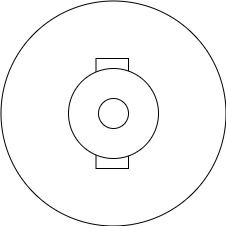
Back EMF in DC motor
- It is seen in the generating action that when a conductor cuts the line of flux EMF gets induced in the conductor .In a DC motor after a motoring action a major start rotating and armature conductor cut the mainflux so is there a generating action existing in a motor after Moni following actions
- There is induced EMF in the rotating armature conductors according to Faraday’s law of electromagnetic induction this induced EMF in the armature always act in the opposite direction to the supply voltage.
- This is according to the Lenz’s law which states that the direction of the induced EMF is always so as to oppose the cause producing it.
- In a DC motor electrical input that is the supply voltage is the cause for the armature current and the motoring action and hence this induced EMF oppose the supply voltage this EMF tries to set up a current through the our nature which is in the opposite direction to that which supply voltage is force in through the conductor.

As this EMF always opposes the supply voltage it is called back EMF and denoted as  .Though it is denoted as
.Though it is denoted as  basically it gets generated by the generating action which we have seen earlier in case of generators. So its magnitude can be determined by the EMF equation which is derived earlier.
basically it gets generated by the generating action which we have seen earlier in case of generators. So its magnitude can be determined by the EMF equation which is derived earlier.

Where all symbols carry the same meaning as seen earlier in case of generators
This EMF issued systematically in figure a so if v is supply voltage in volts & is the value of the armature resistance the equivalent electric circuit can be shown in figure b
is the value of the armature resistance the equivalent electric circuit can be shown in figure b
Voltage equation of DC motor
From the equivalent circuit the voltage equation for a DC motor can be obtained as

The brush drop is practically neglected.
Hence the armature current  is expressed as
is expressed as

Significance of back EMF
Due to the presence of back EMF the DC motor becomes a regulating machine that is motor adjust itself to draw the armature current just enough to satisfy the load demand.
He basic principle of this fact is that the back EMF is proportional to speed 
When load is suddenly put on the motor. Motor tries to slow down. So speed of the motor reduces due to which back EMF also decreases. So the net voltage across the armature Increases and motor draws more armature current.
Increases and motor draws more armature current.
Due to the increased armature current force experienced by the conductors and hence the torque on the armature increases. The increase in the torque is just sufficient to satisfy increase load demand.
When load on the motor is decreased the speed of the motor tries to increase. Hence back EMF increases. This  to reduce which eventually reduces the current drawn by the armature. The motor speed stops increasing when the armature current is just enough to produce the less torque required by the new load.
to reduce which eventually reduces the current drawn by the armature. The motor speed stops increasing when the armature current is just enough to produce the less torque required by the new load.
So back EMF regulate the flow of armature current and it automatically alters the armature current to meet the load requirement. This is the practical significance of the back EMF.
Head start the speed N of the motor is zero hence the back EMF is also zero.
Power equation of a DC motor
The voltage equation of a DC motor is given by
V= 
Multiplying both sides of the above equation by 
V =
= 
This equation is called as power equation of a DC motor
V =net electric power input to the armature measured in watts
=net electric power input to the armature measured in watts
 power loss due to the resistance of the armature called armature copper loss.
power loss due to the resistance of the armature called armature copper loss.
So difference between V and
and  is input losses gives the o/p of the armature.
is input losses gives the o/p of the armature.
So  is called electric equivalent of gross mechanical power developed by the armature.
is called electric equivalent of gross mechanical power developed by the armature.
This is denoted as 
Therefore I/P to the armature-armature copper loss = gross mechanical power developed in the armature

DC shunt motor
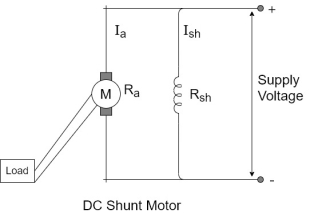
In this type the field winding is connected across the supply as shown in figure
Let  be the resistance of shunt field winding and
be the resistance of shunt field winding and  be the resistance of armature winding.
be the resistance of armature winding.
The value of  very small while
very small while  is quite large. Hence shunt field winding has more number of turns with less cross sectional area.
is quite large. Hence shunt field winding has more number of turns with less cross sectional area.
Numerical Problems).
1) A 220 volt DC motor has an armature resistance of 0.75 ohm. It is drawing and armature current of 30 A, driving a certain load. Calculate the induced EMF in the motor under this condition.
V=200V 
Are the given values
For a motor ,
V=
220= +30*0.75
+30*0.75
 =197.5 V
=197.5 V
This is the induced EMF called a back EMF in a motor
2) Find the useful flux per pole on no load of a 250V 6 pole shunt motor having two circuit connected armature winding with 225 conductors.at normal working temperature the overall armature resistance including brushes is 0.2 ohm. The armature current is 13.3A at the no load speed of 908 RPM.
Solution
V=250 P=6 Z=220 A=2
As two circuit armature

N=908 r.p.m
For a DC shunt motor

250= +13.3*0.2 i.e.
+13.3*0.2 i.e. 
Back emf is given by
is given by



Voltage and current relationship
The voltage across armature and field winding is same equal to the supply voltage V.
The total current drawn from the supply is denoted as line current 


Now flux produced by the field winding is proportional to the current passing through it i.e. 

As long as supply voltage is constant which is generally so in practice, the flux produced is constant.
Hence D.C. Shunt motor is called constant flux motor.
DC series motor
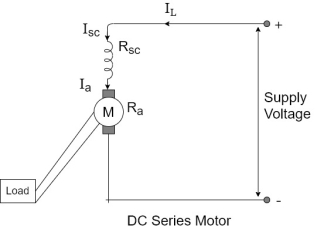
In this type of motor the series field winding is connected in series with armature and the supply as shown in figure. Let  the resistance of all the series field winding then the value of
the resistance of all the series field winding then the value of  is very small and it is made up of small number of turns having large cross section area.
is very small and it is made up of small number of turns having large cross section area.
Voltage and current relationship
Let  be the total current drawn from the supply
be the total current drawn from the supply
So

And,.

Supply voltage has to overcome the drop across series field building in addition to  drop across armature winding.
drop across armature winding.
In series motor entire armature current is passing through the series field winding. So flux produced is proportional to the armature current.
 for series motor
for series motor
DC compound motor
The compound motor consists of part of the field winding connected in series and part of the field winding connected in parallel with the armature.it is further classified as short shunt compound and long shunt compound motor.
Long shunt compound motor
In this type the shunt field winding is connected across the combination of armature and the series field winding as shown in figure

Voltage and current relationship
Let  be the resistance of series field and
be the resistance of series field and  resistance of shunt field winding.
resistance of shunt field winding.
The total current drawn from supply is 
So ,. 
But,
And,
V=
But as


Short shunt compound motor
In this type the shunt field is connected properly in in parallel with armature and the series field is connected in series with the combination as shown in figure.
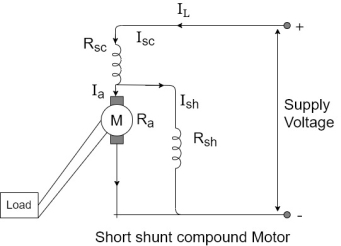
The entire line current is passing through the series field winding

Now the drop across the shunt field winding is to be calculated from the voltage equation

But, 

Drop across shunt field winding=V-

A long shunt compound motor can be of cumulative or differential type. Similarly short shunt compound motor can be cumulative order differential type.
Torque and speed equations
Before analysing the various characteristics of motors, latest device the torque and speed equations as applied to various types of motors
 for the torque equation
for the torque equation
This is because  to a constant for a given motor.
to a constant for a given motor.
Now  is the flux produced by the field winding and is proportional to the current passing through the field winding.
is the flux produced by the field winding and is proportional to the current passing through the field winding.

For a D.C. Shunt motor.  Is constant as long as supply voltage is constant. Hence flux is also constant.
Is constant as long as supply voltage is constant. Hence flux is also constant.
 for shunt motors
for shunt motors
For DC series motor  same as
same as  . Hence flux is proportional to the armature current
. Hence flux is proportional to the armature current 

For series motor lly as 
We can write the speed equation as 
 neglecting brush drop
neglecting brush drop
So for shunt motor the flux is constant

While for series motor flux is proportional to 

These relations play an important role in understanding the various characteristics of different type of motors.
Operation,
Consider- 3Ф slip ring I.M
Cut section diagram:-
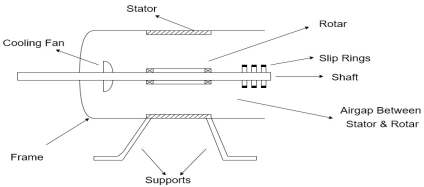
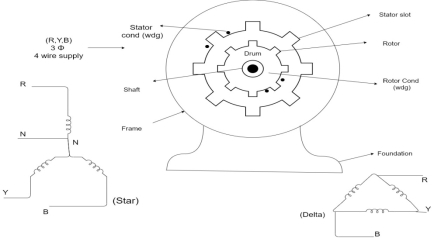
The induction motor has following important parts:-
- Stator :- it is the stationary part of induction motor and it is one of important part in induction motor.
- Rotor:- the rotor is the rotating part of induction motor which consists of rotor wdg.
- Stator winding:- this wdg. Is mounted on devastator and it generates the RMF i.e. rotating magnetic field.
- Rotor winding:- rotor winding is used to rotate the shaft of motor. This wdgis provided on rotor
- Frame :- it provides the mechanical support to the motor. It is the outer covering of motor. It protects the internal parts of motor from damage.
- Shaft:- shaft is used to connect to the load and four rotation.
- Slip rings and brushes:- slip rings are mounted on the shaft which is connected with brushes from which connection is given to the external resistant or rheostat
- Cooling fan:- this is provided for cooling purpose of motor and its internal parts.
Principle of operation of induction motor:

- When the 3Ф A.C supply is connected across the stator of induction motor, the current starts flowing through the stator wdg. i.ethe stator condition.
- Due to this current of flux (Ф) is established in the stator wdg. This flux (Ф) is alternating (changing) in nature. Thus this flux links with the rotor also, and a a Rotating Magnetic Field(RMF) is produced.
- This flux (Ф) inducesemf in the rotor also. The RMF is produced in the air gap between stator and rotor.
- The rotor is rotating part which is till stationary, show the rotating magnetic field is cut by stationary rotor and an EMF is induced in the rotor winding. According to faraday's law of EMI the rotor EMF gives the rise to rotor current which opposes the main cause producing it according Lenz's law.
Types of induction motor:
Two main types depending upon the rotor
- Squirrel cage induction motor (squirrel cage rotor)
- Slip ring induction motor(slip ring or wound rotor)
Induction motor are also available in 1Ф supply i.e.
1. Resistance split phase induction motor
2. Capacitor start induction motor
3. Capacitor start capacitor run induction motor
4. 1Ф induction motor i.e. A.C series motors
5. Shaded pole induction motor
Torque equation of induction motor:-
Torque produced in induction motor depends upon the following factors
1.The rotor power factors ( CosФ) under running condition
2.The rotor current under running condition
3. The part of RMF which induces EMF in rotor wdgi.e. flux (Ф)
We can mathematically say that,
 , As per DC (M) equation
, As per DC (M) equation
But in case of induction motor
Suffix 1 -> used for stator/stator parts (qty)
Suffix 2-> used for rotor/rotor parts(qty)
Therefore,  ----(1)
----(1)
 = flux that induces the EMF in rotor
= flux that induces the EMF in rotor
 = rotor current under running condition
= rotor current under running condition
 = P.F of rotor
= P.F of rotor
But, stator vtg
stator vtg also i.e
also i.e
 ----(2)
----(2)
Transformation ratio i.e. given by 
Therefore,
 and hence
and hence
 also
also
 at slip ’S’ is given by
at slip ’S’ is given by 
And also  at slip ‘S’ is
at slip ‘S’ is  =S.
=S.
Hence  in equation can be replaced by
in equation can be replaced by 
i.e.  U
U
 =
= ----(3)----(
----(3)----( )
)
4 =
= ------(4)
------(4)
Substract (3) and (4) into (1) equation we get,


 (N-m) , Torque equation of I.M.
(N-m) , Torque equation of I.M.


At starting condition slip S=1
So, 
Numerical Problems).
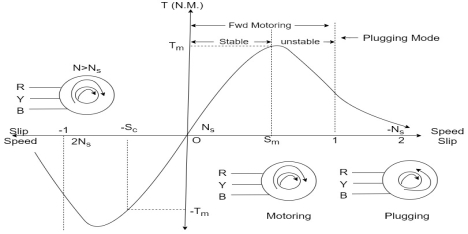
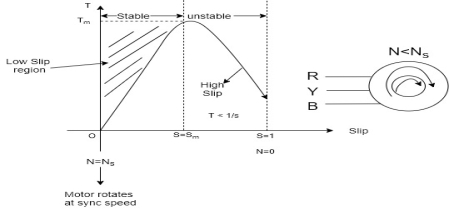
Torque slip region for stable regimen

S= small  -> Negligible
-> Negligible


Unstable:-

 , neglect
, neglect 
 = Constant value
= Constant value
 =high slip region
=high slip region
 and vice versa
and vice versa

Various Torques ;
 at starting s=1 and 4N =0
at starting s=1 and 4N =0
 ----------slip is
----------slip is  i.e..
i.e..
Total Torque

A Single- Phase Induction Motor consists of a single- phase winding which is mounted on the stator of the motor and a cage winding placed on the rotor. A pulsating magnetic field is produced, when the stator winding of the single-phase induction motor shown below is energised by a single- phase supply.

The word Pulsating means that the field builds up in one direction falls to zero and then builds up in the opposite direction. Under these conditions, the rotor of an induction motor does not rotate. Hence, a single -phase induction motor is not self-starting. It requires some special starting means.
If the 1 phase stator winding is excited and the rotor of the motor is rotated by an auxiliary means and the starting device is then removed, the motor continues to rotate in the direction in which it is started.
The performance of the single- phase induction motor is analysed by the two theories. One is known as the Double Revolving Field Theory, and the other is Cross Field Theory.
The double revolving field theory of single- phase induction motor states that a pulsating magnetic field is resolved into two rotating magnetic fields. They are equal in magnitude but opposite in directions. The induction motor responds to each of the magnetic fields separately. The net torque in the motor is equal to the sum of the torque due to each of the two magnetic fields.
The equation for an alternating magnetic field is given as

Where βmax is the maximum value of the sinusoidally distributed air gap flux density produced by a properly distributed stator winding carrying an alternating current of the frequency ω, and α is the space displacement angle measured from the axis of the stator winding.
So, the equation (1) can be written as

The first term of the right-hand side of the equation (2) represents the revolving field moving in the positive α direction. It is known as a Forward Rotating field. Similarly, the second term shows the revolving field moving in the negative α direction and is known as the Backward Rotating field.
The direction in which the single- phase motor is started initially is known as the positive direction. Both the revolving field rotates at the synchronous speed.
ωs = 2πf in the opposite direction.
Thus, the pulsating magnetic field is resolved into two rotating magnetic fields. Both are equal in magnitude and opposite in direction but at the same frequency.
At the standstill condition, the induced voltages are equal and opposite as a result; the two torques are also equal and opposite. Thus, the net torque is zero and, therefore, a single- phase induction motor has no starting torque.
Methods for Making Single Phase Induction as Self- Starting Motor
The single-phase induction motors are not self-starting because the produced stator flux is alternating in nature and at the starting, the two components of this flux cancel each other and hence there is no net torque. The solution to this problem is that if we make the stator flux rotating type, rather than alternating type, which rotates in one particular direction ,then the induction motor will become self-starting.
Now for producing this rotating magnetic field, we require two alternating flux, having some phase difference angle between them. When these two fluxes interact with each other, they will produce a resultant flux. This resultant flux is rotating in nature and rotates in space in one particular direction only.
Once the motor starts running, we can remove the additional flux. The motor will continue to run under the influence of the main flux only. Depending upon the methods for making asynchronous motor as Self-Starting Motor, there are mainly four types of single -phase induction motor namely,
- Split phase induction motor,
- Capacitor start inductor motor,
- Capacitor start capacitor run induction motor,
- Shaded pole induction motor.
- Permanent split capacitor motor or single value capacitor motor.
Applications:
These are used in low power applications and widely used in domestic applications as well as industrial. And some of those are mentioned below
- Pumps
- Compressors
- Small fans
- Mixers
- Toys
- High speed vacuum cleaners
- Electric shavers
- Drilling machines
The rotating and stationary parts of an electrical machine can be called as rotor and stator respectively. The rotor or stator of electrical machines acts as a power-producing component and is called as an armature. The electromagnets or permanent magnets mounted on the stator or rotor are used to provide magnetic field of an electrical machine. The generator in which permanent magnet is used instead of coil to provide excitation field is termed as permanent magnet synchronous generator or also simply called as synchronous generator.
Construction of Synchronous Generator
In general, synchronous generator consists of two parts rotor and stator. The rotor part consists of field poles and stator part consists of armature conductors. The rotation of field poles in the presence of armature conductors induces an alternating voltage which results in electrical power generation.
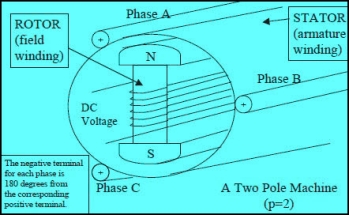
Construction of Synchronous Generator
The speed of field poles is synchronous speed and is given by

Where, ‘f’ indicates alternating current frequency and ‘P’ indicates number of poles.
Synchronous Generator Working Principle
The principle of operation of synchronous generator is electromagnetic induction. If there exists a relative motion between the flux and conductors, then an emf is induced in the conductors. To understand the synchronous generator working principle, let us consider two opposite magnetic poles in between them a rectangular coil or turn is placed as shown in the below figure.
Now, if we consider a practical synchronous generator, then field magnets rotate between the stationary armature conductors. The synchronous generator rotor and shaft or turbine blades are mechanically coupled to each other and rotate at synchronous speed. Thus, the magnetic flux cutting produces an induced emf which causes the current flow in armature conductors. Thus, for each winding the current flows in one direction for the first half cycle and current flows in the other direction for the second half cycle with a time lag of 120 degrees (as they displaced by 120 degrees). Hence, the output power of synchronous generator can be shown as below figure.
